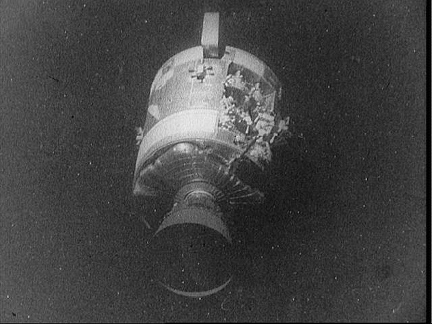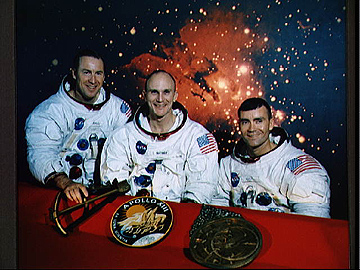The astronauts for the Apollo 13 mission were
James A. Lovell, John L. Swigert, and Fred W. Haise. Lovell
and Haise were the two astronauts selected to walk on the Moon.
Swigert's role was to orbit the Moon in the command module.
Their mission lasted from April 11-17, 1970.
Their command module was called "Odyssey." Their lunar
module was "Aquarius."
Trouble occurred when they were more than halfway to the Moon.
An electrical surge occurred inside a fuel cell, caused by contact
between two electrical wires.
Note that a fuel cell is a device which combines liquid hydrogen
and liquid oxygen to produce electrical power and water.
Accounts differs somewhat as to intermediate events.
One explanation is that this electrical surge sent sparks flying
from a circulating fan into one of the service module's oxygen
tanks. Note that the purpose of the fan was to stir the liquid
oxygen. As a result of the sparks, the oxygen tank exploded.
Another explanation is that Teflon insulation was ignited by
the sparks, producing a fire in the service module. This fire
then caused the pressure inside one of the oxygen tanks to increase
until it ruptured.
Regardless, both accounts agree that an oxygen tank exploded.
This explosion caused another oxygen tank to leak as well. The
command module's oxygen, water, and electrical power supplies
decreased rapidly as a result.
The lunar landing was thus aborted.

Apollo 13 Service Module after the Explosion. The damage is on
the right-hand side.
The astronauts took refuge in their lunar module, which they
used as a lifeboat. The lunar module was designed to sustain
two people for 50 hours. But the three astronauts survived in
this module for 95 hours. They carefully rationed water to six
ounces a day.
The temperature inside the lunar module was very cold. Here
is an excerpt from James Lovell: "Fred and I even put on
our heavy lunar boots. Jack didn't have any, so he put on extra
longjohns. When you were moving around, the cold wasn't so bad,
but when you were sitting still, it was unbearable."
Fred Haise said that the temperature inside the lunar module
dipped to 32 degrees F. He also said that the body heat of the
three astronauts "helped keep you warm."
Note that the lunar module was designed for two astronauts.
Inside, it was not much larger than a telephone booth. Yet it
served as a lifeboat for all three men. Lovell and Haise were
unable to wear their full lunar suits due to limited room.
Despite all the problems, the astronauts returned safely to Earth.
NASA released this statement after the flight:
Apollo 13 must officially be classed as a failure . . . But in
another sense, as a brilliant demonstration of the human capability
under almost unbearable stress, it has to be the most successful
failure in the annals of space flight.
|
